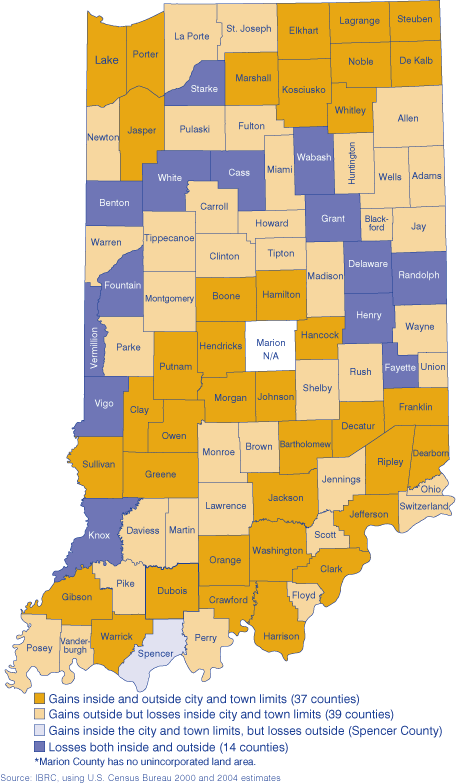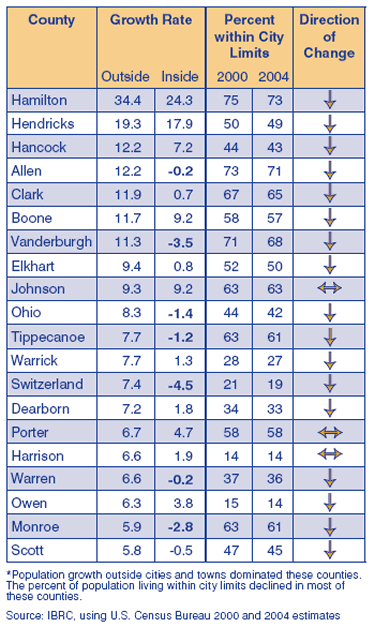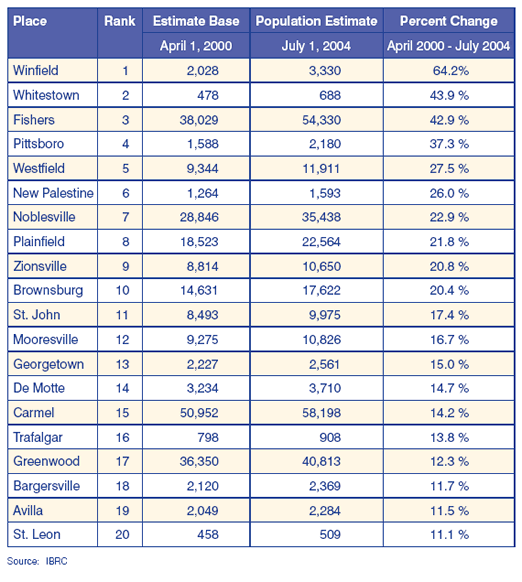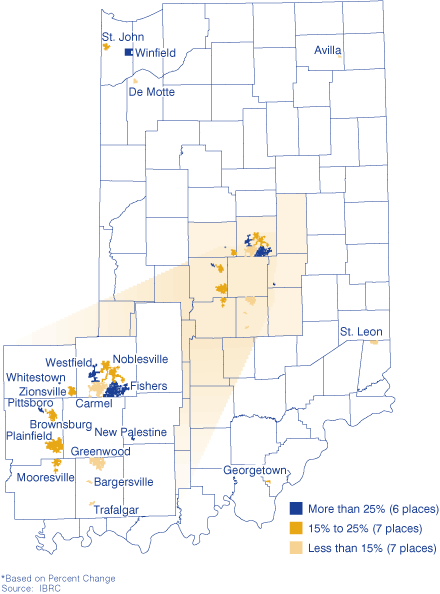Beyond the Limits: Significant Population Gains Occur Outside Cities and Towns
Is living close to the city, but not actually in the city, the wave of Indiana’s future? Analysis of the latest population estimates for Indiana’s cities, towns and the unincorporated parts of our counties lead to that tantalizing question.
Between 2000 and 2004, the unincorporated areas of our counties gained more people (111,000) than our cities and towns (43,000). People are making a distinct choice, a choice that allows them to be in close proximity to cities and towns in their counties, but not living within the city or town limits (see Figure 1).
Figure 1: Source of Population Change, 2000 to 2004

One of Indiana’s historical advantages has been its proximity to the
majority of the U.S. population, a benefit to businesses and residents alike.
Planes, trains and automobiles can take Hoosiers to any number of large metropolitan
areas within 250 miles. Such advantages now seem to apply to lifestyle choices
of people opting to live close to Fort Wayne, Evansville or Terre Haute, but
not actually in those cities. Notably, of the 20 counties experiencing the
greatest percentage growth in population outside cities and towns, all are
either part of a metropolitan or micropolitan statistical area (see Table
1).
Table 1: Population Trends,* 2000 to 2004

Before we think our cities and towns will disappear, it is important to note the significant increases in population that have occurred over the past four years, most notably in the up-and-coming cities and towns near our larger metro areas. More findings for the Hoosier State:
- Indiana now has one fewer city in the 100,000+ category, as Gary dipped below that mark with an estimated population of 99,516.
- None of Indiana’s four remaining cities with more than 100,000 people (Indianapolis, Evansville, South Bend and Fort Wayne) saw a population gain from 2003 to 2004.
- Population has decreased over the four-and-one-quarter years since Census 2000 in three of those four cities. Indianapolis saw a gain of only 0.3 percent over this period, while Evansville, South Bend and Fort Wayne sustained losses of 3.6 percent, 2.3 percent and 0.5 percent, respectively. (However, Fort Wayne would show a gain of 6.6 percent if growth due to boundary annexations was included.)
- Of Indiana’s cities with populations greater than 50,000, Fishers had the fastest “true” growth since Census 2000; Table 2 shows an increase from about 38,000 to more than 54,000 residents (43 percent). If you consider growth due to post-2000 boundary annexations, Carmel’s gains exceeded Fishers’, surging from about 38,000 to more than 58,000 (54 percent).
Table 2: Indiana's Fastest Growing Cities and Towns, 2000 to 2004

- Among the largest 25 Hoosier cities and towns, Noblesville (ranked 22nd) experienced the next fastest growth since the last census with an increase of about 23 percent. Greenwood also turned in a double-digit increase at 12 percent and ranks 18th in estimated population. Other top 25 cities showing some growth are Lawrence (17th) and Portage (23rd), each posting a gain of about 5 percent. Also, Mishawaka (15th) increased 3.8 percent, Merrillville (25th) saw a 2.3 percent gain, while Columbus (19th) picked up a meager 0.5 percent.
- The town of Winfield (Lake County) experienced the highest percentage increase since Census 2000 at 64 percent (see Figure 2). The town’s 2004 population is estimated to be 3,330. Whitestown edges out Fishers for second fastest growth at 44 percent, but has an estimated population of only 688 residents. Other places showing growth greater than 25 percent are Pittsboro at about 37 percent, as well as Westfield at 27.5 percent and New Palestine at 26 percent (see Table 2).
Figure 2: Fastest Growing Cities and Towns, 2000 to 2004

- Indianapolis’ status as the 12th largest city in the nation will likely change soon, as 13th-ranked Jacksonville, Fla. is on a trajectory to eclipse Indy before the end of 2005. Fort Wayne ranks 84th nationally, while Evansville and South Bend place at 201st and 225th, respectively.
When U.S. cities from the 100,000+ group are ranked by the estimated percent change in population since Census 2000, Indiana’s four largest cities can be found at the bottom third of the list. Among all 251 cities in that group, Indianapolis ranks 175th, Fort Wayne ranks 193rd, South Bend ranks 222nd and Evansville ranks 244th. Only time and the next decennial census will show if the trend in population growth outside of cities will continue. More information on this topic can be found on STATS Indiana at www.stats.indiana.edu.
By Carol O. Rogers, Executive Editor, and
Vincent Thompson, Economic Analyst
Indiana Business Research Center, Kelley School of Business, Indiana
University
